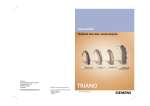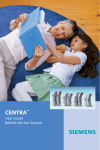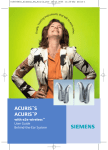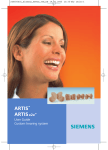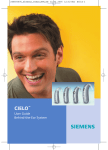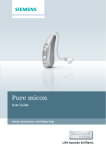Download Siemens 2 D SP User guide
Transcript
User guide Behind-the-Ear-Instruments PRISMA 2 PRISMA 2 P PRISMA 2 Siemens Hearing Solutions PRISMA 2 D SP A friendly guide to your new Siemens hearing instruments Congratulations! You have decided in favour of hearing instruments from Siemens. You have taken an important step towards being able to hear and understand better once again. Your new hearing instruments will be your constant companions from now on. With these technically perfected hearing instruments you profit from our many years research and experience in microelectronics. Soon it will be easy for you to hear again. Good hearing is an important requirement for your physical well being. With your new hearing instruments, which will accompany you daily, you will again enjoy taking an active part in the world of speech and music. And as with any constant companion, you’ll need some time at first to get used to handling your hearing instruments. With a little patience, we trust that your new hearing experience will be all the more pleasant for you. For this purpose we are providing you with this brief user guide for your hearing instruments it should contribute to deepening your friendship with your new partners in the matter of better hearing. We want to help you to handle your hearing instruments correctly, so that they will become an important part of your life. Wishing you much success, Your Siemens Team 2 The best way to use your new hearing instruments In this brief guide you will find instructions for inserting, placing and adjusting your hearing instruments. There are also tips and information on correct handling, cleaning, care and battery changing. And naturally information about how you can solve some failures yourself if you cannot visit a hearing instrument specialist immediately. One important note: Your hearing success depends largely on how well your instruments fit in the ears and how carefully you maintain and handle them. This is your Instrument Contents: PRISMA 2 / PRISMA 2 P Page 5 2/2 P PRISMA 2 D SP Page 13 2 D SP All Applicable to all PRISMA 2 instruments How to insert your ear mould Page 24 Handling batteries Page 26 Notes for cleaning and care Page 27 The best way to handle your hearing instruments Page 29 How to solve some failures yourself Page 30 Hearing training made easy Page 32 3 PRISMA 2/PRISMA 2 P Description of the PRISMA 2/PRISMA 2 P hearing instruments Page 6 Battery changing Page 7 Safety notes for batteries Page 8 How to switch your instrument on/off Page 8 Program button Page 9 Children’s safety device Page 10 Audio input Page 11 2/2 P Applicable to all PRISMA 2 instruments How to insert your ear mould Page 24 Handling Batteries Page 26 Notes for cleaning and care Page 27 The best way to handle your hearing instruments Page 29 How to solve some failures yourself Page 30 Hearing training made easy Page 32 5 Description of the PRISMA 2, PRISMA 2 P hearing instrument Microphone opening Program button Selection of operating mode M = hearing via microphone T = induction coil switched on O = Off Battery compartment with lock For your instrument you will need Battery Type 13. 6 Battery changing ▼ ▼ Open the battery compartment Insert the battery Close the battery compartment ▼ 2/2 P When inserting the battery please pay attention to the plus side on the battery. The plus (+) side of the battery is always the smooth side. You can recognise the minus (–) side by the coloured ring. You should always keep spare batteries at hand. If you feel you cannot change the battery yourself, ask someone to help you: a family member, friend or your hearing instrument specialist. 7 Safety notes for batteries WARNING Keep batteries away from children! Batteries must not be swallowed. Remove the batteries when the instrument is not in use over a prolonged period. Replace leaking batteries without delay. Do not throw away your dead batteries! Return them to your hearing instrument specialist for proper, environmentally conscious disposal. How to switch your instrument on/off Set the switch to position M The hearing instrument is ready for use without any further adjustment. Even if the sound level changes, your instrument is always adjusted correctly according to your personal needs. Thus soft sounds aren’t lost and loud sounds aren’t amplified or are amplified only insignificantly. 8 Program button You can adapt to a changed hearing situation by lightly pressing the program button. For instance, you are better able to understand the person you’re talking to even in disturbing background noise. You simply press the button to choose between two programs. Your acoustician can adapt the two programs exactly to your individual needs. In this way it is possible to take 2/2 account of different microphone characteristics. A beep indicates which hearing program is selected. One beep is when changing to microphone program “1” or to “T” setting. Two beeps is when changing to microphone program “2”. If required, your hearing instrument specialist can switch the beeps off. 9 P Children’s safety device unlock lock 10 Your instrument is equipped with a “children’s safety device“. This is intended to prevent the unintentional removal of batteries from their compartment, such as by small children. This safety device is on the inner side of the hearing instrument. Please use a tool suited to the purpose to open or close the safety device. Pushing the slide towards the battery compartment locks the battery compartment; pushing the slide towards the ear hook unlocks the battery compartment so that it can be opened. Audio input Your hearing instrument has an audio input. This enables the connection between hearing instrument and accessories. In this way you can understand better in certain hearing situations. Take care that before you use the audio input you pull off the protective foil. The audio shoe connects the audio cable with your instrument. Plug the audio shoe on to the hearing instrument (Fig. 1 and Fig 2). Remove the audio shoe from the hearing instrument (Fig. 3). 2/2 P Fig. 1 Fig. 2 Fig. 3 Safety note for instruments with audio input The audio input can only be connected to power supplied devices if they fulfil at least the safety provisions of IEC 65 / DIN VDE 0860. 11 PRISMA 2 D SP Description of the PRISMA 2 D SP hearing instruments Page 14 Handling batteries Page 15 Battery changing Page 16 Setting the loudness Page 18 Program switch Page 18 Children’s safety device Page 20 Audio input Page 21 2 D SP Applicable to all PRISMA 2 instruments How to insert your ear mould Page 24 Handling batteries Page 26 Notes for cleaning and care Page 27 The best way to handle your hearing instruments Page 29 How to solve some failures yourself Page 30 Some useful tips Page 31 Hearing training made easy Page 32 13 Description of the PRISMA 2 D SP hearing instrument Ear hook Sound inlet openings Volume control Programming socket Program switch Audio input Battery compartment with lock and on/off switch 14 Handling batteries So-called zinc-air batteries are used today almost exclusively in hearing instruments to minimize environmental damage. These batteries require oxygen for operation, which they absorb from the air. The battery is activated as soon as the protective foil is pulled off and is used up even if you do not use your hearing instrument. You should always pull off the protective foil only if you actually use the battery. Also, do not leave the batteries in your hearing instruments if you do not use them over 2 a longer period. The batteries can leak and damage the instruments. The batteries keep for from a few days up to several weeks according to the way they are used. You can recognize when a change of batteries becomes necessary, because your hearing instruments become noticeably quieter towards the end of the battery’s life. Then it is time for new batteries. Two warning tones sound once per minute, indicating that you must insert a new battery. … Your hearing instrument specialist can switch off the warning tones if required. Zinc-air batteries which are almost completely used up show the following behaviour: After switching on the instruments they function completely normally, but then rapidly become quieter. The more the battery is used up, the faster the gain falls off. You must then replace such batteries by new ones. 15 D SP Battery changing Removing the battery Open the battery compartment as shown in the figure. Up to the first stop = the instrument is then switched off Completely open = to change the battery open the battery compartment completely by applying more force Normally the battery drops out when the battery compartment is completely open. Should this not be the case, you can lightly tap the instrument or push the battery out with a pencil as shown in the picture. Inserting the battery Important! Make sure to note the polarity of the battery! If the battery is inserted incorrectly, the battery compartment can be closed only with considerable force. This will damage the instrument. Closing the battery compartment Close the battery compartment by pressing from below with your finger tip. The instrument is switched on. 16 Three useful tips: The plus (+) side of the battery is always the smooth side. You can recognize the minus (–) side by the coloured ring. You should always keep spare batteries at hand. If you feel you cannot change the battery yourself, ask someone to help you: a family member, friend or your hearing instrument specialist. Please do not throw used batteries into household refuse. Return them to your hearing instrument specialist for environmentally correct disposal. Caution! Please keep batteries out of the reach of children. They are damaging to health when swallowed. 2 D SP 17 Setting the loudness PRISMA 2 D SP hearing instruments are fully automatic. It is therefore not necessary for you to change the loudness manually. However, if you still wish to do so, PRISMA 2 D SP offers you a volume control. louder 2 turn quieter Your hearing instrument specialist can program the possible adjustment range for you. If you do not want to use the volume control, then your hearing instrument specialist can also switch it off. Turning the volume control then does not change the adjustment of your PRISMA 2 D SP hearing instrument. Program switch PRISMA 2 D SP hearing instruments have 4 hearing 1 programs. Three are selected T with a program switch. The fourth program is activated 2 as soon as the audio shoe is plugged to the audio input. Your hearing specialist will program them according to your individual needs. 18 Program“1“ Program“3“ (telecoil) Program“2“ Function of the program switch without audio shoe (recommended setting) Switch position 1 - Program "1" For the most frequently required hearing situation e.g. at home or work place Switch position 2 - Program "2" For special situations according to your individual needs, e.g. music. Switch position T - Program "3" For telephoning and for using induction loops e.g. in churches, theatres or lecture rooms. Using the "T" position for telephoning requires that the telephone is suitable for hearing instruments and emits a corresponding magnetic field. Not all modern phones, especially cordless telephones and mobile phones produce a magnet field. In such cases we recommend that you phone, if possible, with program "1" or "2". Switching between the positions 1-T-2 is indicated by beep tones. One beep tone to position "1", two beep tones to position "2" and three beep tones to position "T". Function of the program switch with audio shoe 2 plugged on The audioprogram is activated as soon as the audio shoe is plugged on. Switch position 1 - Program "1" As without audio shoe Switch position 2 - audio input mode The heard signal comes via audio shoe only Switch position T - Mixed mode Microphone signal and signal via audio shoe are heard together Switching between the positions 1-T-2 with audio shoe plugged on is indicated by beep tones. One beep tone to position "1", four beep tones to position "2" and "T". Your hearing instrument specialist can switch off the beeps if required. 19 D SP Children’s safety device Your instruments are equipped with a “children’s safety device“ . This is intended to prevent the unintentional removal of batteries from their compartment, such as by small children. locked To lock the children’s safety device open the battery unlocked compartment up to the first stop. Push the slide in the battery compartment to the right with a suitable tool. To unlock the battery compartment again, open the battery compartment up to the first stop. Push the slide in the battery compartment to the left with a suitable tool. If you feel you cannot do this yourself, your hearing instrument specialist will be pleased to help you. 20 Audio input Your hearing instruments are equipped with an audio input. This enables the connection between hearing instrument and accessories. It helps you to understand better in certain hearing situations. Fitting an audio shoe Open the battery compartment up to the first stop, open the flap under the 1-T-2 switch, hook the audio shoe in from the front and press it to the rear into the detent on the inner curved piece. Switching off instrument with audio shoe Press the audio shoe to the rear, up to the first stop. 2 D SP Removing the audio shoe Press the audio shoe to the front, unhook the audio shoe and close the flap again. Safety instructions for hearing instruments with audio input The audio input may be connected to line-operated equipment only if this fulfils at least the safety requirements of IEC 65 / DIN VDE 0860. 21 Applicable to all PRISMA 2 instruments PRISMA 2 PRISMA 2 P PRISMA 2 D SP How to insert your ear mould Page 24 Handling batteries Page 26 Notes for cleaning and care Page 27 All The best way to handle your hearing instruments Page 29 How to solve some failures yourself Page 30 Hearing training made easy Page 32 23 How to insert your ear mould Make sure that your hearing instrument is turned off. The battery compartment must be opened up to the stop. Grip the ear mould between your thumb and index finger and place the tip carefully into your auditory canal. You may find it helpful to pull your ear slightly upwards or to the rear. You may want to push the ear mould very gently with your index finger. Once inserted, you should feel that the ear mould is correctly placed. Now place your hearing instrument behind your ear and switch it on. Close the battery compartment fully. 24 Tip: Practice inserting and removing your hearing instruments correctly. One easy way to practice is to sit down at a table. Place a mirror in front of you and prop your elbows on the table so you can guide your hands easily and safely.This will help you stay relaxed and comfortable while you practice. All 25 Handling batteries So-called zinc-air batteries are used today almost exclusively in hearing instruments to minimize environmental damage. These batteries require oxygen for operation, which they absorb from the air. The battery is activated as soon as the protective foil is pulled off and is used up even if you do not use your hearing instrument. You should always pull off the protective foil only if you actually use the battery. Also, do not leave the batteries in your hearing instruments if you do not use them over a longer period. The batteries can leak and damage the instruments. The batteries last from a few days up to several weeks according to the way they are used. You can recognise when a change of batteries becomes necessary, because your hearing instruments become noticeably quieter towards the end of the battery’s life. Then it is time for new batteries. Four warning tones sound once per minute, indicating that you must insert a new battery. Your hearing instrument specialist can switch off the warning tones if required. Zinc-air batteries which are almost completely used up show the following behaviour: After switching on the instruments they function completely normally, but then rapidly become quieter. The more the battery is used up, the faster the gain falls off. You must then replace such batteries by new ones. 26 Notes for cleaning and care Ear wax accumulates on your ear mould. This can lead to inflammation in your auditory canal if the instruments are not cleaned regularly. Therefore: 1. It is essential to detach the ear mould from your behindthe-ear instrument and place it in a cleaning bath for at least 15 minutes. Caution: The hearing instrument itself cannot tolerate any moisture. All 2. Bring your hearing instruments regularly to your hearing instrument specialist, on the schedule that he or she recommends, to have the hearing tube changed and the instrument checked. 27 Two more tips: You should place your hearing instruments in a “dry bag“ with a special moisture-attracting capsule overnight.The drying capsule draws damaging moisture out of the instruments. Your hearing instrument specialist stocks the special care sets and dry bags you need to maintain your hearing instruments and keep them in good condition. 28 The best way to handle your hearing instruments Your new hearing instruments are highly sensitive instruments. This naturally requires some care in their handling. All They should then always give you good service. Caution! As with all electrical, non gas-encapsulated instruments, the hearing instruments must not be operated in explosion-endangered rooms. 29 How to solve failures yourself In selecting your PRISMA 2 hearing instruments you have chosen extremely dependable devices. However, should a fault occur, it can usually be corrected quickly. Important tips: If the instrument whistles Test the instrument yourself by closing the sound outlet opening with your fingertip. If the whistling disappears, the instrument is in order. Check that the ear mould sits properly in your ear. Also test the hearing tube for leaks. If the whistling noise is still audible, only your hearing instrument specialist can provide assistance. Sound outlet opening 30 Some useful tips: Never expose your hearing instruments to extreme temperatures or high humidity. Never let them lie in the blazing sun. Do not wear them when taking a shower or when using hairspray. In short-wave therapy or if you work or are medically treated with strong magnetic or high-frequency fields or X-rays, under no circumstances may you wear the instruments during the therapy. Make sure to switch off the instruments when not in use.This saves the batteries. If you don’t wear your instruments for a longer time, remove the batteries. Batteries can leak out. Replace batteries that have leaked out without delay. If the hearing instrument is too quiet Most likely, you need to insert a new battery. If it is still too quiet, clean the instrument or the ear mould and hearing tube, following the directions in the chapter “Notes for cleaning and care“. If neither a new battery nor cleaning helps, as a precaution you should ask your hearing instrument specialist to test your hearing again. All If the hearing instrument does not work at all Is the instrument turned on? Is the battery compartment completely closed? Is the battery inserted correctly? Is it possible that the battery is dead? If none of these hints help, you should visit your hearing instrument specialist. 31 Hearing training made easy Hearing instruments reproduce an abundance of sounds which frequently haven’t been experienced for many years. Every person reacts differently the first time he or she wears a hearing instrument. The familiarisation phase therefore differs from person to person. There are people who are quite happy to wear their hearing instruments the whole day long right from the start. Others will regard it as a foreign body at first. You’ll notice that even after a relatively short time the positive new hearing experience prevails and you’ll find your hearing instruments to be something quite normal. Hearing training helps you here. You’ll become more and more perfect, and naturally securer, step by step. 1st step Discover simple sounds in your direct surroundings Wear your instruments in different situations in different rooms. Repeat this exercise and you’ll become more and more familiar with the sounds. 2nd step Experience sounds outdoors First choose quiet surroundings for this. For instance, while taking a stroll you’ll discover all sorts of sounds in the ”silence” of the forest. 32 3rd step Become familiar with your own voice You’ve already made remarkable progress! You’ve become much more familiar with the sounds in your daily environment. As an exercise read out aloud and concentrate on your own voice. 4th step Learn to understand the voices of others Wear the instrument when you speak with someone in your family. Make a date with a friend. Explain your new situation and ask the person you’re talking to to speak at a normal conversational level. Exercise: Have sentences read out to you and repeat these sentences. 5th step Get used to conversations in a group Conversation in a group of people speaking among themselves is one of the most difficult hearing situations. Try to distinguish between the voices by noting their specific tonal colour and their characteristic rhythm, and fit them to the individual persons. All Don’t be discouraged and repeat the exercise – think about your goal: to be able to take part in conversations again. 6th step Visit public events At lectures or in church find a place as close as possible to the speaker. Also choose a place at the front in theaters and concert halls. Avoid niches, boxes and places behind pillars. 33 7th step Telephoning with your hearing instrument You can telephone in the “normal“ M position. Set the switch on the hearing instrument to T if you have difficulties in understanding. Place the telephone receiver behind your external ear against the hearing instrument and find the most favorable and loudest transmission.You can activate the telephone coil and the microphone by pressing the program button so that you can hear the normal surroundings. Your hearing instrument fulfils the IEC 118-13 standard with regard to electromagnetic compatibility (concerning for example interference by external radiotelephones). If you use a radiotelephone (GSM) yourself, unfortunately unavoidable disturbances can occur in your hearing instrument under certain circumstances because of the high field strengths. This is certainly unpleasant but no reason for concern. Your hearing instrument isn’t defective. 8th step Go on further voyages of discovery – undertake everything that gives you pleasure and experience the whole wide world of hearing. 34 We’re happy that you can hear well again! Once good hearing returns to your everyday life – and you can enjoy both speech and music again – then we at Siemens are also satisfied. Because we’ve put all our knowledge and skill into developing your hearing instruments! All 35 Siemens Audiologische Technik GmbH Gebbertstrasse 125 91058 Erlangen Germany www.hearing-siemens.com Subject to change without prior notice Order No. A91100-M5100-1033-01-7600 Printed in Germany 35018 12.03.JK 78 19 191




































